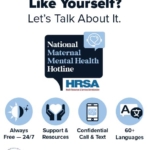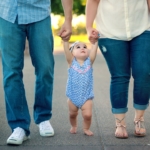In our weekly clinical rounds, we recently discussed how motherhood is such a unique and personal experience for each woman. Often it is assumed that this transition into a new role is easy when for many it is not. How we assess a woman’s experiences during the postpartum period is often limited to just her mood. I recently came across a new self-report instrument, The Being a Mother Scale (BaM-13) developed by Stephen Matthey which attempts to assess the “wider domain of the woman’s experience of motherhood” rather than just the presence or absence of a postpartum mood disorder.
As awareness regarding postpartum distress or depression increase and intervention programs and treatments are developed, we need to be able to assess how these interventions may improve the woman’s satisfaction and experience of her new role as a mother. Matthey points out that it would be incorrect to presume that low mood, as measured on the Edinburgh Postnatal Depression Scale (EPDS) reflects dissatisfaction with motherhood.
In the article, the author reviews several measures available prior to BaM-13:
- The Postpartum Adjustment Questionnaire by O’Hara (1992) is a 61-item self-report measure covering the domains of work in the home, outside the home, and the woman’s relationships with friends, relatives, her baby and other children. The woman rates the amount of time spent in each domain and evaluates her performance adequacy and the perception of other’s evaluation of her adequacy and whether this changed since the birth.
- The modified Work Leisure and Family Life Questionnaire (WLFQ; Boath et al, 1995) consists of 12 items, of which 10 items focus on the woman’s relationship with her baby.
- The Experience of Motherhood Questionnaire (EMQ; Astbury, 1994) is a 20-item self-report measure that in Mathey’s opinion assesses the broader domain of motherhood adequately, but was developed using mothers of 2-year old children and may not reflect the issues related to caring for an infant.
The BaM-13 was designed to assess women with newborns, infants and toddlers up to 3 to 4 years of age. The scale assesses a women’s experience over the previous 2 to 3 weeks. It was designed to be a brief measure that would be clinically useful to a wide range of health care providers and would be sensitive to change within research studies where the focus is “to enhance many aspects of the women’s perception of her role as mother.”
The 13 items were developed based on an extensive literature review and significant experience conducting perinatal mental health research and are based upon consistent themes that emerged from these different sources. The areas covered by the BaM-13 include: social isolation, regret, sense of confidence, relationship with the child, satisfaction with support, coping; and guilt. Areas not covered are quality of the mother and child’s sleep, the feeding experience, and the experience of maintaining the many different roles (e.g., partner; employee/employer; friend and daughter).
The questionnaire was used to assess several different populations of mothers. Samples included 496 community mothers presenting for routine baby-health checkups, 102 “baby care mothers” attending a facility for infant sleep or other care difficulties, and 17 “treatment mothers” seeking treatment for postpartum distress.
A cut off score of 9 or more on the entire scale has been suggested to be useful to screen for women who concurrently report possible high levels of distress. The author suggests that the scale is better used for clinical inquiry for each item, and that any score of 2 or 3 should be further investigated and may provide a clear line of possible intervention for the mother. Mathey concludes that the BaM-13 is a useful clinical and research tool for those working in the perinatal and early childhood area. He suggests that clinically it can help provide women with normative information about how difficult experiences are reported by others and it can help the clinician explore some of the difficulties the woman may be experiencing as mothers to a wide range of ages.
The Being a Mother-13 (BaM-13) scale asks questions which are relevant to a mother’s experience which is an important contribution to the field as it may help clinicians engage women in conversations about this difficult and important new role of motherhood. This scale may also help women further by allowing them to discuss these items with family and friends as well their health care providers.
April Hirschberg, MD
Matthey S. Assessing the experience of motherhood: the Being a Mother Scale (BaM-13). J Affect Disord. 128(1-2):142-52, 2011.








hello. can I have full ‘Being a mother scale’ I need it to make my diploma. how can I have it please?
I would contact the authors.
Hello, Can I have the Being a mother Scale? I need it to make my diploma. Thank you.
Thank you for your comment. I would recommend contacting the authors of the study, as we do not have a copy of the scale for public issue.